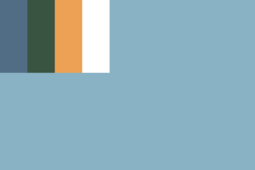Flag and coat of arms of Freice: Difference between revisions
No edit summary |
No edit summary |
||
| Line 36: | Line 36: | ||
* [https://www.chargrilled.co.uk/t-shirts/prodimages/staticimages/square/g0pleasegoaway_g_White.jpg/ Department for for Public Services, Policing, and Emergencies - Flag Protocol] | * [https://www.chargrilled.co.uk/t-shirts/prodimages/staticimages/square/g0pleasegoaway_g_White.jpg/ Department for for Public Services, Policing, and Emergencies - Flag Protocol] | ||
[[Category:Freice]] | |||
[[Category: | |||
Revision as of 20:35, 30 June 2021
 | |
| Use | Civil and state flag, civil and state ensign |
|---|---|
| Proportion | 1:2 |
| Adopted | 17 January 1970 |
| Design | A light blue field with a rectangle on the upper hoist-side corner bearing the colours blue, green, yellow, and white in vertical bars. |
| Designed by | Deza Tudjego and Toqu Ejista |
The flag of Freice is the national flag of the Country of Freice, used to represent the nation at home and overseas. It consists of a light blue field with four vertical stripes of blue, green, yellow, and white in the upper-left corner. The flag was first adopted in 1970 to replace the first flag of Freice, a banner featuring the same four stripes found in the current flag but in horizontal form. It's position was enshrined in law in the Constitution of Freice in 1971[1].
History
The first flag that was used to represent Freice featured four horizontal bars of blue, green, yellow, and white. This flag was designed by Deza Tudjego, a political figure aligned with the Committee for Liberation, a paramilitary and political organization working for the independence of Freice from colonial rule. The flag came to be used by the Committee as their official flag and, because of this, came to be associated with Frecian independence.
Upon independence in 1969, the four-bar banner was adopted as the national flag of Freice due to its association with Frecian independence and its visibility amongst the Frecian people. However, controversy over the Committee for Liberation's role in the killing of a policeman and a woman in 1964 created discontent amongst some over the use of a flag so closely associated with the organization. Toqu Ejista, a member of the Constituent Assembly, created a new variant, featuring the same colours, but in a vertical form, in the top-left corner, with a blue field. This new flag was approved by the Constituent Assembly in January 1970, its use finally formalized in the Constitution enacted the following year.
Design and symbolism
The colours of the flag represent both political and geographic meanings. The vertical bars, originally used by the Committee of Liberation, link back to the campaign for independence and, more broadly, Freican sovereignty and independence. The colours themselves carry geographic meanings; the blue represents the sky (the dark colour linking to the cultural festivals historically carried out in the evening), the green represents the land, the yellow represents the sun, and the white represents the peace that exists between these co-existent elements, and between them and the Freician people.
The blue field represents the ocean that surrounds Freice and the importance of the sea and water in Frecian life. Moreover, the four bars in the upper-left hoist corner represents Freice's position surrounded by water and Anteria's all-encompassing nature.
Gallery
References
- ↑ Department for Home Affairs, Education, Transport, and Telecommunications: "The design and use of the national flag were formally laid down in the Constitution of the Country of Freice.' Additional regulations have been laid down in the Flags and Symbols Act, 1982."
